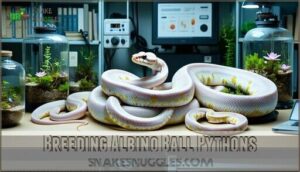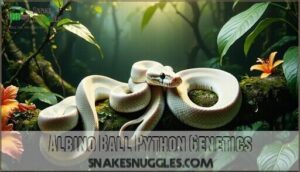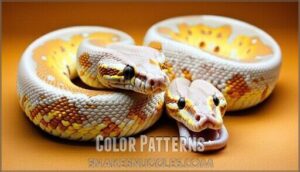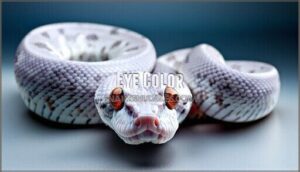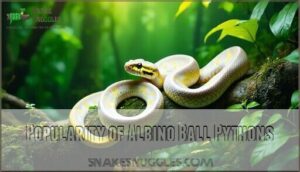This site is supported by our readers. We may earn a commission, at no cost to you, if you purchase through links.
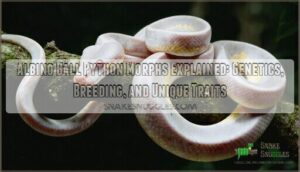 The ball python world operates on a color palette most snakes never access—vivid yellows bleeding into creamy whites, all punctuated by those unmistakable ruby eyes.
The ball python world operates on a color palette most snakes never access—vivid yellows bleeding into creamy whites, all punctuated by those unmistakable ruby eyes.
Albino ball python morphs strip away melanin through a recessive mutation, revealing pigmentation that breeders have spent decades refining into dozens of distinct varieties.
What started as a rare genetic quirk in wild-caught specimens now fuels an entire breeding industry, where combining the albino gene with other mutations produces everything from high-contrast "bumblebees" to pastel-washed "candies."
Understanding how these morphs work—from basic recessive inheritance to sophisticated co-dominant pairings—unlocks both the science behind their appearance and the strategy for creating your own striking combinations.
Table Of Contents
- Key Takeaways
- Albino Ball Python Morphs
- Breeding Albino Ball Pythons
- Albino Ball Python Genetics
- Albino Ball Python Appearance
- Popularity of Albino Ball Pythons
- Frequently Asked Questions (FAQs)
- What are the different types of albino ball pythons?
- How rare are albino pythons?
- What is the most sought after ball python morph?
- What is the prettiest ball python morph?
- How long does the breeding process take?
- What are the specific lighting requirements?
- How much do albino ball pythons cost?
- Are albino ball pythons harder to care for?
- How long do albino ball pythons live?
- What do albino ball pythons eat?
- Conclusion
Key Takeaways
- Albino ball pythons result from a recessive genetic mutation that eliminates melanin production while preserving yellow and white pigments, creating their signature bright coloration and ruby-red eyes.
- Strategic breeding pairs albino genetics with other morphs like Pinstripe, Pied, or Enchi to produce designer combinations with enhanced contrast, unique patterns, and intensified color saturation.
- Market accessibility has improved dramatically since 1992, with basic albino morphs now priced at $200-$250 while rare designer combinations command $400-$1,000+ based on genetic complexity and visual traits.
- Understanding recessive inheritance patterns allows breeders to predict offspring outcomes and selectively refine traits across generations, transforming genetic knowledge into consistently reproducible results.
Albino Ball Python Morphs
There’s something truly magical about seeing your first albino ball python, especially when you realize just how many morphs and wild color combos are out there waiting to surprise you. Whether you’re drawn in by the sharp Color Intensity of classic Albino Ball Python Morphs or keen to spot those ultra-rare Designer Morphs, Morph Identification quickly becomes an adventure.
Each Ball Python Morph boasts Pattern Uniqueness—like Lavender, Pied, or Black Pastel—offering a blend of tradition and innovation. As breeders experiment, today’s color morphs hint at tomorrow’s Future Morphs, constantly expanding what’s possible in the Albino Ball Python Morphs.
Breeding Albino Ball Pythons
Breeding albino ball pythons opens up a world of creative possibilities, where you can combine genes to craft stunning new morphs. The key is understanding which traits play well together and how selective pairing can boost or improve the snake’s appearance.
Let’s look at three essential breeding strategies that help you produce impressive offspring.
Selective Breeding
When you’re serious about refining albino ball python traits, selective breeding becomes your most powerful tool. This strategic approach lets you sculpt the course of your collection through deliberate Trait Selection and clear Breeding Goals:
- Identify target characteristics—whether it’s enhanced contrast, specific patterns, or unique Designer Morphs
- Choose breeding candidates that consistently express desired genetics
- Pair specimens thoughtfully to heighten traits across generations
Ball Python Breeding demands patience, but Morph Combinations like banana pastel reveal possibilities beyond the ordinary. Through Selective Breeding, you’ll tap into Genetic Diversity while maintaining Ethical Considerations, transforming albino ball python morphs into living masterpieces.
Compatible Morphs
Albino ball python morphs offer exciting breeding potential when paired strategically. Combining albino genetics with pattern-altering color morphs produces stunning visual outcomes. The lack of melanin defines their unique appearance.
Consider these genetic interactions:
| Morph Combination | Visual Outcome |
|---|---|
| Albino × Pinstripe | Thin dorsal stripe, brighter yellows |
| Albino × Pied | Cream base with bold yellow patches |
| Albino × Spider | Wobble pattern with intensified contrast |
| Albino × Leopard | Fragmented pattern, high contrast |
Designer morphs like super mojave create some of the rarest morphs available. These ball python breeding projects reveal how morph combinations shape the progression of captive genetics.
Enhancing Contrast
Contrast isn’t just about luck—it’s about choosing the right genetic partners to make those yellows pop and those whites glow. Selective pairing with morphs like Enchi or Candy intensifies color saturation, while husbandry practices—proper lighting effects and diet influence—also shape visual impact.
Here’s how to boost contrast:
- Pattern manipulation: Combine albino genetics with Pewter or Pinstripe for sharper borders
- Designer morphs: Candino and Toffino pairings preserve brightness across generations
- Genetics matter: Research color morphs that improve rather than wash out your albino ball python
Albino Ball Python Genetics
Understanding the genetics behind albino ball pythons helps you predict breeding outcomes and appreciate why these snakes display such striking variation. The key lies in how the recessive albino gene interacts with other genetic factors to produce different levels of contrast and coloration.
Let’s break down the three main genetic concepts that shape these beautiful morphs.
Recessive Mutation
The secret to every albino ball python’s stunning appearance lies in a single genetic twist—a recessive mutation that strips away dark pigmentation, leaving behind vibrant yellows, pure whites, and unmistakable ruby-red eyes. This recessive gene must be inherited from both parents for these visual traits to manifest. Understanding inheritance patterns is crucial for predicting outcomes and maintaining genetic health in breeding programs.
| Genetic Factor | Normal Ball Python | Albino Ball Python |
|---|---|---|
| Gene Expression | Melanin produced | No melanin (amelanistic) |
| Visual Traits | Browns and blacks | Yellows and whites with red eyes |
| Inheritance Pattern | Dominant pigmentation | Recessive mutation (two copies needed) |
Mutation frequency remains relatively low in wild populations, which explains why these snakes command attention in the reptile community.
Amelanistic Trait
When melanin—the pigment responsible for dark browns and blacks in most reptiles—is completely absent from a ball python’s genetic blueprint, you’re left with what scientists call an amelanistic trait. This recessive gene blocks melanin production entirely, but here’s the fascinating part: other pigments like xanthophores and erythrophores remain active, painting these snakes in vivid yellows and creamy whites.
When melanin vanishes from a ball python’s genes, the amelanistic trait leaves vivid yellows and whites painted by surviving pigments
That’s why albino ball pythons don’t appear colorless—instead, they showcase warm golden tones that make each genetic mutation a living work of art. Wild rarity makes first discovery specimens incredibly valuable to breeders pursuing selective outcomes.
Contrast Variations
Not every albino ball python wears its pigment-free genetics with the same intensity—contrast levels can shift dramatically depending on which genes team up in the breeding process.
Pattern intensity and color saturation vary widely across albinism morphs:
- High contrast albino ball pythons showcase crisp separation between bright yellows and clean whites, with minimal color bleeding
- Low contrast individuals display muted hue differences where patterns blur together, creating softer transitions
- Light sensitivity affects scale iridescence differently, causing some color morphs to fade under direct illumination
Selective breeding targets maximum pattern definition.
Albino Ball Python Appearance
Once you understand the genetics behind albinism, the next question is: what does an albino ball python actually look like?
These snakes showcase striking visual traits that set them apart from their wild-type cousins. Let’s break down the two defining features of their appearance.
Color Patterns
Albino ball pythons paint themselves in a palette that would make any sunset jealous—think buttery yellows bleeding into creamy whites, punctuated by bursts of orange and coral that dance across their scales. Pattern variations range from bold, irregular blotches to delicate ribbons that wrap around their bodies.
Morph combinations heighten these traits—crossing an albino with other genetic markers shifts color intensity and phenotype dramatically, creating everything from high-contrast flames to soft, washed-out pastels.
Eye Color
If you’ve ever locked eyes with an albino ball python, you know those ruby-red orbs aren’t just beautiful—they’re a window into the snake’s unique genetic makeup. The recessive gene behind albinism strips away melanin, leaving behind pink or red iris pigmentation that glows under light.
This amelanistic trait creates stunning eye color variance, but it also makes these snakes more light-sensitive. You’ll need to monitor ocular health carefully and avoid harsh lighting to protect their vision.
Popularity of Albino Ball Pythons
Albino ball pythons have come a long way since their introduction to the market in 1992. What once commanded sky-high prices has become more accessible to enthusiasts, though these stunning snakes still hold significant value.
Let’s look at three key factors driving their continued popularity among reptile keepers.
Affordability
Once priced as luxury items that only serious collectors could afford, albino ball pythons have become surprisingly accessible to everyday reptile enthusiasts. Pricing trends shifted dramatically as captive breeding expanded, making these stunning morphs budget options for newcomers. Today’s market value reflects balanced supply and demand, with purchase tips emphasizing quality over cost alone.
Key factors driving affordability include:
- Widespread captive breeding reducing scarcity
- Competitive ball python market value
- Lower albino ball python pricing than designer combinations
- Improved albino ball python care and maintenance knowledge
Variety of Morphs
Beyond the lower price tag, albino ball pythons offer something even more exciting—a dazzling spectrum of morphs that can transform your collection from simple to stunning.
These color morphs showcase striking pattern variance and breed diversity, from lavender-tinged beauties to bold pied combinations.
You can explore designer morphs like Banana Albino or Black Pastel Albino, each displaying unique morph characteristics through fascinating color genetics and snake morphology variations that make every ball python morph truly one-of-a-kind.
Demand and Value
The beauty and breeding potential of these snakes keep Collector Demand thriving. Market Trends show that while basic Albino Ball Python morphs now sell for $200-$250 as hatchlings, designer morph characteristics—like Banana Albino or Black Pastel Albino—push prices toward $400-$1,000+.
Price Factors include genetic makeup, age, and pattern contrast. Breeder Networks and Auction Sales connect enthusiasts seeking specific Ball Python Morphs, ensuring market value stays strong for these fascinating reptiles.
For more information on purchasing these unique pets, visit the albino ball pythons section.
Frequently Asked Questions (FAQs)
What are the different types of albino ball pythons?
Think of albino ball pythons like a painter’s palette—some blends burst with sharp contrast between vivid yellow and white, while others showcase softer, buttery tones. High contrast albinos display those eye-catching patterns, but low contrast varieties offer subtler yellow shades that create their own appeal.
As hatchlings mature, their contrast often intensifies, revealing the true character of each morph’s unique color genetics and breed variations.
How rare are albino pythons?
In the wild, albino ball pythons are exceptionally rare due to their striking coloration making them highly visible to predators.
The recessive traits require both parents carrying the albino gene, making genetic odds slim in natural populations where survival is already challenging for these conspicuous snakes.
What is the most sought after ball python morph?
Among ball python morphs, opinions vary widely among breeders and collectors, but several consistently dominate Morph Market listings and Snake Trends discussions. The Piebald, with its unpredictable white patches, draws focus alongside the Blue-Eyed Leucistic’s ghost-like appearance.
Meanwhile, the Albino Ball Python remains a cornerstone genetic mutation that breeders frequently combine with other ball python morphs to create designer variations, influencing morph prices across the hobby.
What is the prettiest ball python morph?
Choosing the prettiest Ball Python morph comes down to personal taste, but many enthusiasts gravitate toward Designer Morphs combining Albino Ball Python genetics with other Color Morphs.
These combinations create stunning Visual Appeal through Pattern Genetics and unique Color Variations that showcase Snake Beauty in striking ways.
How long does the breeding process take?
Ball python reproduction isn’t a quick affair—expect several months from pairing to hatchlings. Snake breeding demands patience as you track cycles, maintain precise conditions, and wait through roughly 55 days of egg incubation.
Breeding time varies with maturity rates and genetic timing, but your diligence pays off when healthy babies emerge.
What are the specific lighting requirements?
Albino ball pythons don’t need UVB lighting like some reptiles, but ambient lighting helps maintain a natural photoperiod.
Use low-intensity heat lamps for temperature regulation, avoiding direct exposure since these snakes are light-sensitive.
How much do albino ball pythons cost?
Imagine trying to buy a rainbow—albino ball pythons feel almost that magical, yet they’re surprisingly within reach.
Hatchlings start around $200–250, while adults can climb to $400–1,000 depending on the morph. Designer combinations with unique genetics push prices higher, sometimes exceeding $1,000 from reputable breeders who provide health guarantees and proper care documentation.
Are albino ball pythons harder to care for?
Regarding care requirements, you won’t find albino ball pythons much different from standard morphs. They need the same temperature control, humidity levels, and feeding schedule as any ball python.
However, their light sensitivity means you’ll want to avoid direct sunlight and provide adequate hiding spots—a minor adjustment that’s easy to implement with proper reptile care techniques.
How long do albino ball pythons live?
One keeper’s ten-year-old albino ball python still coils gently around their arm during interaction sessions, proving these snakes can be long-term companions.
With proper Ball Python Care addressing Health Issues and Longevity Tips, your Albino Ball Python’s Age Expectancy usually reaches 20-30 years in captivity.
Care Effects and Lifespan Factors—like temperature control, diet quality, and routine health monitoring—directly influence how long these Ball Python Characteristics manifest, so understanding Ball Python Genetics and Albino Ball Python Varieties helps you support their longevity.
What do albino ball pythons eat?
Your albino ball python thrives on a diet of appropriately sized frozen-thawed rodents, primarily mice and rats.
Proper reptile nutrition means matching prey items to your snake’s size, ensuring dietary needs are met every 7-10 days for healthy albino ball python care.
Conclusion
Think of albino ball python morphs as a painter’s canvas—once you understand the base, you can layer endless combinations. Mastering recessive genetics lets you predict outcomes, while pairing compatible morphs transforms standard albinos into showstoppers.
Whether you’re drawn to high-contrast bumblebees or pastel candies, the science remains consistent: selective breeding unlocks predictable results. Your collection’s potential grows exponentially when you grasp how amelanism interacts with other traits, turning genetic knowledge into living art.

